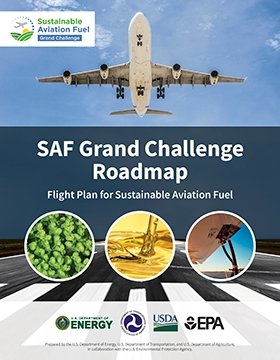
|
An interagency team led by the DOE, DOT, and USDA worked with EPA, other government agencies, and stakeholders from national labs, universities, nongovernmental organizations, and the aviation, agricultural, and energy industries to develop the SAF Grand Challenge Roadmap: Flight Plan for Sustainable Aviation Fuel. |
The Biomass Research and Development Board's Sustainable Aviation Fuel Interagency Working Group’s goals include:
- Ensuring sustainable aviation fuel R&D efforts reflect critical needs
- Advancing a revised and coordinated federal R&D roadmap on sustainable aviation fuels
- Developing and scaling best practices to foster the success of sustainable aviation fuels in commercial, business, and military aviation sectors.
What Are Sustainable Aviation Fuels?
Sustainable aviation fuels (SAF) are drop-in fuel blending components derived from renewable or waste-based feedstocks that, relative to petroleum-based fuels, provide reduced CO2 emissions. SAF can increase the economic, social, and environmental sustainability of aviation operations. They are an important bioeconomy market because they can be produced from multiple biomass feedstocks and conversion pathways, and are compatible with existing aviation engines, distribution infrastructure, and storage facilities.
Why Is SAF Important for the Bioeconomy?
The aviation sector is highly motivated to use cost effective SAF for commercial, business, and military sectors because of the economic growth, job creation, and environmental benefits they offer. Availability of SAF is critical for the aviation industry to meet its significant international carbon reduction commitments.
What Are the U.S. Government’s Goals for SAF?
In 2021, the government-wide SAF Grand Challenge was launched. In addition to the objectives outlined in this interagency initiative, the federal government has several goals for expanding SAF. These include:
- Sharing information and key findings among federal agencies and coordinating communication activities
- Ensuring R&D efforts reflect the critical needs of commercial, business, and military aviation
- Developing best practices to foster the success of SAF supply development for commercial, business, and military aviation sectors.
Federal agencies involved in this area include:
- U.S. Department of Agriculture
- U.S. Department of Transportation – Federal Aviation Administration
- U.S. Department of Energy
- U.S. Department of Defense
- Environmental Protection Agency
- National Aeronautics and Space Administration.
Federal agencies support many activities to expand the use of SAF, including:
- Fuel performance, safety evaluation, and specification development with the ASTM International
- Development of SAF feedstocks and supply chains
- Optimization of SAF production processes and economic and environmental assessments.
What Progress Has Occurred?
The Sustainable Aviation Fuel Interagency Working Group has made the following progress to help the adoption of SAF:
- Published the SAF Grand Challenge Roadmap: Flight Plan for Sustainable Aviation Fuel
- Coordinated agency information exchange and stakeholder engagement to understand industry developments
- Performed collaborative interagency research
- Developed outreach and education programs
- Issued relevant reports that might be of interest to the SAF research, production, and end-user communities, such as Sustainable Aviation Fuel: Review of Technical Pathways.
Visit BR&D Board Publications to access publications related to the SAF Grand Challenge.

